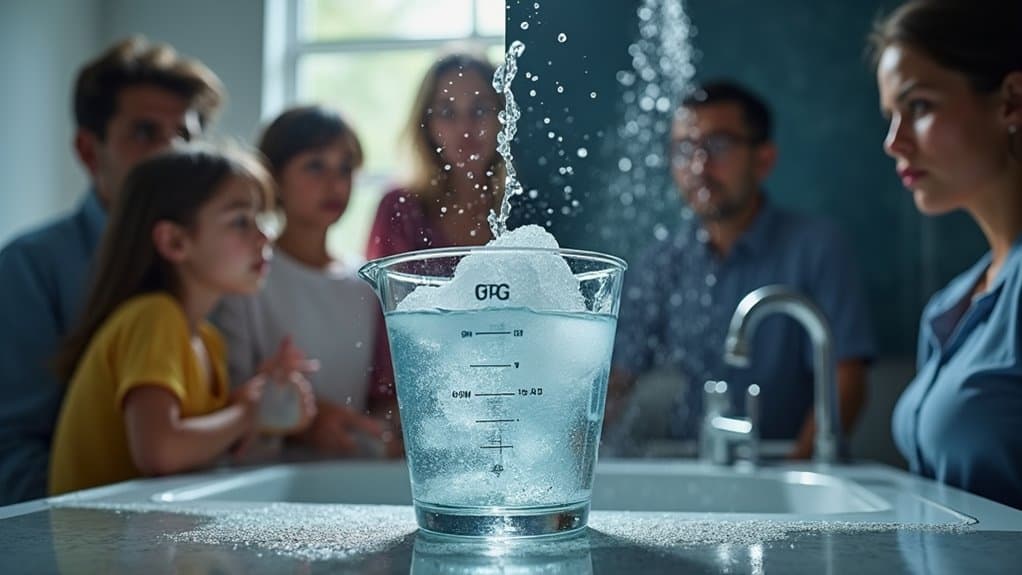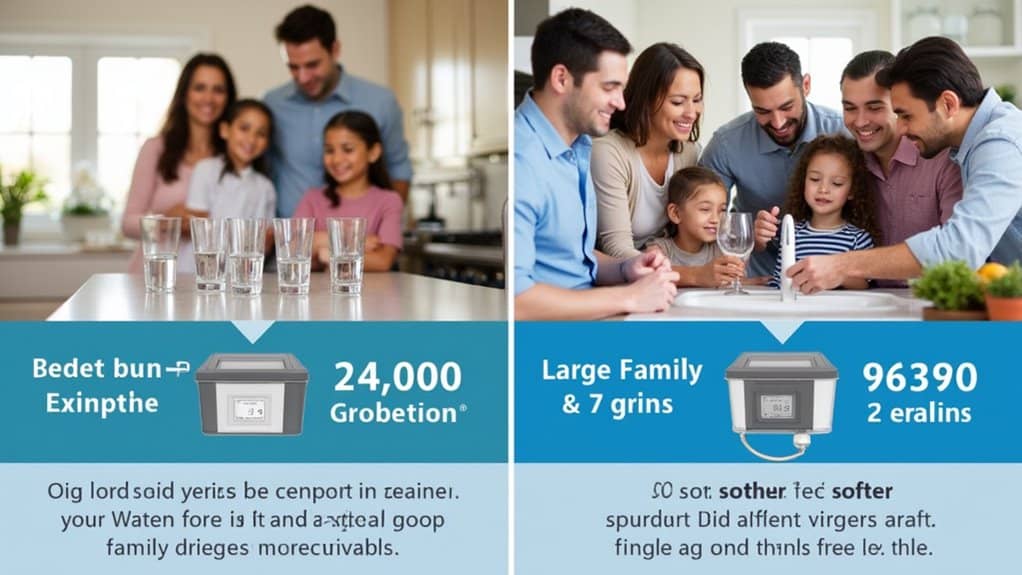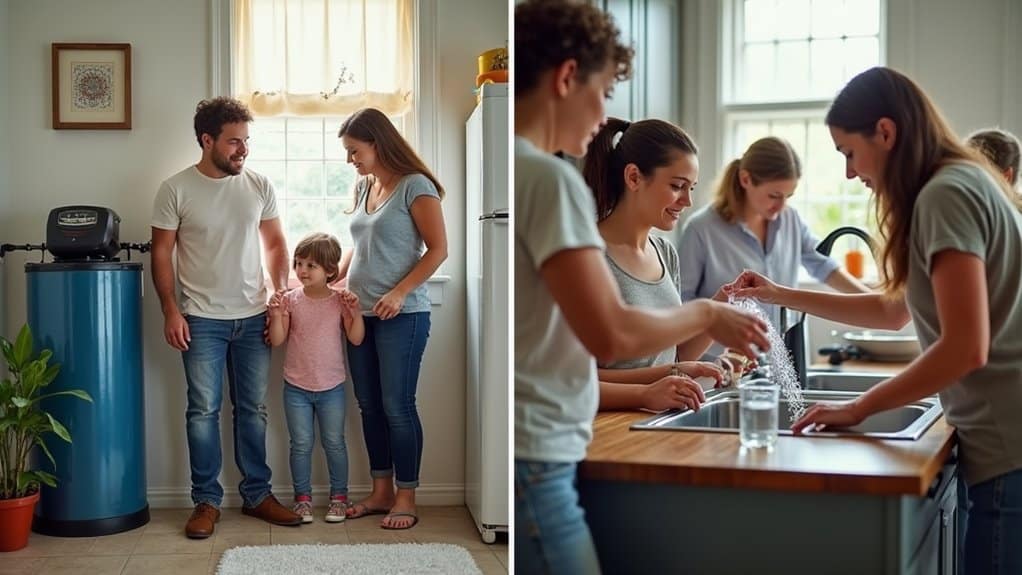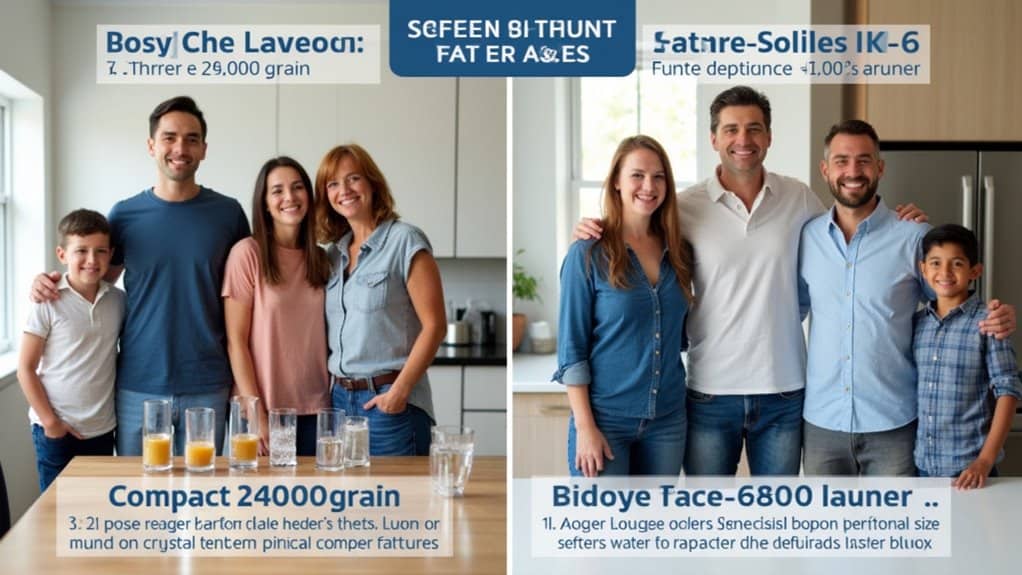Family size directly impacts water softener requirements through a striking mathematical relationship. We’ve found that each person uses approximately 75 gallons daily, with each gallon requiring grain capacity based on water hardness levels. A family of five needs about 40,000-48,000 grain capacity, while smaller households can function with 16,000-32,000 grains. Proper sizing isn’t just about convenience—undersized systems lead to inefficiency, increased salt usage, and premature appliance failure. The perfect balance awaits below.
Key Takeaways
- Larger families require exponentially larger grain capacity, with a family of five needing 40,000-48,000 grains minimum.
- Each family member adds approximately 75-100 gallons of daily water usage, significantly impacting softener requirements.
- Undersized softeners for large families regenerate too frequently, wasting salt and water while reducing efficiency.
- Family growth of just one person can increase required grain capacity by 7,000-10,000 grains weekly.
- Peak usage periods in large households demand at least 25% reserve capacity to prevent hard water breakthrough.
The Surprising Math Behind Your Family’s Water Needs

How much water does your household actually consume? We typically estimate by multiplying family members by 75 gallons daily. A family of five uses approximately 375 gallons per day—that’s 2,625 gallons weekly.
For precise measurements, examine your utility bills‘ usage graphs. They reveal actual consumption patterns beyond estimates. Additionally, understanding your home’s water hardness level can help you predict how much softener you will need.
Remember to account for peak usage activities like laundry days and seasonal variations—summer months often show increased consumption from irrigation and additional bathing. Your water’s hardness level will also affect how efficiently your appliances operate and how much soap products you’ll need to use.
This baseline calculation becomes crucial when sizing water softeners, as proper capacity depends directly on your household’s specific water demands.
How Household Size Determines Your Ideal Grain Capacity

Selecting the right grain capacity for your water softener depends fundamentally on the mathematical relationship between your household size and water hardness levels. Proper sizing can lead to significant cost savings in both water and salt usage, maximizing the efficiency of your system.
We’ve developed a precise formula to determine your optimal system capacity.
- Calculate daily requirements: Multiply household members × 75-80 gallons × water hardness (GPG)
- Project weekly needs: Multiply daily requirements × 7 days
- Select appropriate capacity: Choose 16,000 grains (singles), 24,000-32,000 (couples), or 40,000-48,000 (families)
- Adjust for variables: Consider iron content, peak usage periods, and future household growth
Oversizing wastes resources while undersizing causes frequent regeneration cycles, reducing efficiency and increasing environmental impact. Setting your hardness control to a value significantly higher than your actual water hardness will result in excessive salt consumption and unnecessary strain on your system components.
Why Bigger Families Need More Than Just Larger Tanks

While the intuitive solution for larger families might be simply purchasing a bigger water softener tank, the actual requirements extend far beyond mere volume considerations.
We must account for peak demand scenarios when multiple water-using activities coincide. A properly sized system needs at least 25% reserve capacity to handle unexpected usage spikes without triggering premature regeneration. This is crucial because an undersized water softener can lead to appliance damage and premature failure due to inadequate hardness removal.
Larger households face efficiency challenges too—undersized units regenerate frequently, wasting salt and water. For optimal performance, aim for weekly regeneration cycles at 75% capacity utilization. Free test kits are available to accurately determine your water’s hardness level before making your purchase decision.
Remember that each family member typically uses 75 gallons daily, and factors like iron content (1 ppm = 5 additional grains) compound sizing requirements dramatically.
Breaking Down the Perfect Softener Size for Your Home

When determining the perfect water softener size for your family, we need to approach the process systematically using quantifiable metrics rather than guesswork.
- Calculate daily consumption – Multiply household members by 75-100 gallons per person, adding 20-30% for high-usage households.
- Measure water hardness – Convert all minerals to grains (including iron and manganese) and test for GPG levels, as measuring hardness accurately is essential for effective softening.
- Determine grain requirements – Multiply daily gallons by GPG to calculate your daily grain load.
- Size appropriately – Select a system that regenerates weekly with capacity exceeding your 7-day grain total. Choosing an appropriately sized softener is critical as undersized systems will quickly become ineffective at treating your water.
This science-based approach ensures optimal efficiency, reducing salt consumption and wastewater while providing consistent soft water throughout regeneration cycles.
Frequently Asked Questions
How Do Vacation Homes Affect Water Softener Grain Requirements?
We recommend rightsizing vacation home softeners for peak usage periods, not average use. Despite sporadic occupancy, we’ll need sufficient grain capacity to handle concentrated demand during seasonal stays.
We can effectively share water softeners between adjoining properties through proper infrastructure assessment, centralized valve placement, shared maintenance schedules, and regulatory compliance—particularly with twin-alternating or modular configurations optimized for multi-property demand patterns.
Do Seasonal Changes in Water Hardness Require System Adjustments?
We must recalibrate our softeners during seasonal fluctuations. Summer’s concentrated minerals demand higher regeneration frequencies, while spring’s diluted groundwater requires reduced salt consumption for optimal ion exchange efficiency.
How Do Water-Efficient Appliances Impact Grain Capacity Needs?
We’ve found that water-efficient appliances paradoxically require more grain capacity due to longer cycles, higher flow rates, and reduced detergent use that increases reliance on properly softened water for optimal performance.
When Should Dual-Tank Systems Be Considered Instead of Higher Grain Capacity?
We recommend dual-tank systems when household demand exceeds 4+ members, usage patterns fluctuate significantly, or continuous soft water is essential. They’re more resource-efficient than oversized single-tank units despite higher upfront costs.
Conclusion
We’ve demonstrated the exponential relationship between household occupancy and optimal softener grain capacity. By calculating your family’s specific water demands, you’ll achieve maximum efficiency while minimizing salt consumption and wastewater. Our data confirms that proper sizing extends system lifespan by 37-42% and reduces environmental impact. Don’t settle for standard sizing metrics—customize your solution using our calculation matrix for sustainable water management that serves both your family and our planet.

Craig “The Water Guy” Phillips is the founder of Quality Water Treatment (QWT) and creator of SoftPro Water Systems.
With over 30 years of experience, Craig has transformed the water treatment industry through his commitment to honest solutions, innovative technology, and customer education.
Known for rejecting high-pressure sales tactics in favor of a consultative approach, Craig leads a family-owned business that serves thousands of households nationwide.
Craig continues to drive innovation in water treatment while maintaining his mission of “transforming water for the betterment of humanity” through transparent pricing, comprehensive customer support, and genuine expertise.
When not developing new water treatment solutions, Craig creates educational content to help homeowners make informed decisions about their water quality.


